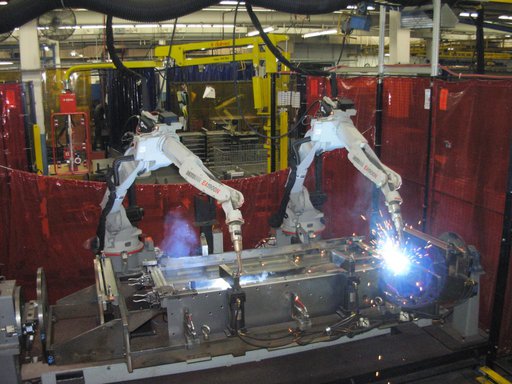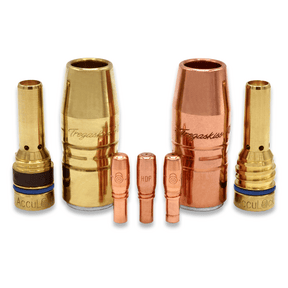5 Tips for Improving Robotic Welding

Robotic MIG welding can provide companies with very significant gains in productivity and excellent return on investment — when done right. Unfortunately, companies often make the mistake of focusing too much on big picture items like the power source and robotic arm, neglecting the small but equally important details like the welding wire, MIG gun and consumables.
While the power source and robot arm certainly are important components to consider, even the most carefully chosen and configured robot system can fail to reach its potential without the right components to support the system.
That said, below are several tips for maximizing your robotic welding productivity and reducing robot downtime through proper wire, gun and consumables selection.
1. Select the Right Wire
Because robotic welding involves very precise tolerances and even minute variations in the wire feed process can result in unacceptable welds, it is important to choose a wire designed to feed smoothly through the drive rolls and liner. Wires engineered specifically with robotic applications in mind often provide better feeding characteristics than those designed for all-purpose use.
Another consideration peculiar to robotic applications is the arc starting performance of the wire. A wire that produces unreliable and inconsistent arc starts can negate the productivity benefits of a robotic system by creating substantial down time, or downstream rework.
For many robotic MIG applications, a metal-cored wire will provide excellent weld quality, metal deposition, mechanical properties, bead appearance and travel speed. Because it contains deoxidizers and other arc stabilizers in the core of the wire, metal-cored wire also produces very little to no spatter, which reduces post-weld cleanup and the frequency with which the welding gun must be cleaned. This is particulary evident when welding over mill scale.
Another benefit unique to metal-cored wire is that it reduces sub-surface porosity caused by extended wire stick-out and changes in gun angles, which often goes undetected during visual weld inspection. Further, the wide, round penetration profile of metal-cored wire allows a greater margin of error in wire placement, particularly in fillet welds where fusion at the root is critical.
Metal-cored wire won’t be the right solution for every robotic application, however, so be sure to check with a robotic welding expert or wire manufacturer prior to making a purchase decision.
Responsible for delivering the electrical current to the welding wire and shielding gas to the weld pool, the MIG gun consumables play a crucial role in ensuring weld quality. The challenge lies in delivering consistent current under extreme heat for hours and days without interruption.

2. Choose the Right Consumables
Because robotic welding involves a lot of arc-on time, it is important to choose consumables that are durable. Tregaskiss® AccuLock™ R consumables have tapered connections to ensure reliable conductivity and reduce heat buildup that could lead to premature failure.
AccuLock contact tips also have greater mass at the front end and are designed so 60% of the tip is buried in the gas diffuser. Both features help protect the contact tip from the heat of the arc and make it last longer, reducing downtime for changeover. The contact tips feature coarse threads and a long tail that concentrically aligns the contact tip in the gas diffuser before the threads engage. This design virtually eliminates cross-threading, so there is less downtime for troubleshooting associated with this issue.
For pulsed welding applications, which can be especially harsh on contact tips, AccuLock HDP contact tips are a good choice. The hardened insert helps the contact tip last 10 times longer than those made of copper or chrome zirconium.
As part of a common consumable platform™, AccuLock R consumables share a common contact tip that can be used with Bernard® AccuLock S consumables for semi-automatic MIG guns. Because most shops that use robots also have semi-automatic applications, using an interchangeable consumables system can reduce inventory footprint and downtime associated with retrieving the incorrect consumables when replacement is needed.
3. Consider a Front-Load Liner
Front-loading liners allow robotic MIG welding operators to replace the liner from the front of the gun instead of the back end, where the welding cable connects to the wire feeder. These liners can be changed in much less time than standard liners, providing the opportunity to change a liner on a proactive basis during short periods of downtime, rather than waiting for the next available time allotted for Preventative Maintenance (PM).
A front-load liner typically requires the operator to install a retainer at the back end of the gun during initial installation. Following this initial installation, the operator simply removes the front-end consumables, pulls the old liner out, slides the new liner on over the wire and replaces the consumables.
4. Select the Right Filler Metal Package
The benefits of robotic MIG welding rely on volume and uptime, so it should be no surprise that reducing robot downtime for routine wire changeovers can be one of the most effective ways of maximizing return on investment and productivity.
The ideal filler metal package for a robotic application should be large enough to reduce wire changeovers as much as possible, yet not so large that the same wire sits on the shop floor for more than a few days. Filler metal is usually shipped in air-tight containers, and once opened, it runs the risk of absorbing moisture, dust, oil or other contaminants that can affect its welding performance.
Also consider where the filler metal will be located within the welding cell. In some cases, weld cell configurations make large filler metal drums impractical, but when possible, stocking at least one extra filler metal package near the robot can help reduce downtime.
Finally, selecting recyclable filler metal packaging can reduce cost and the amount of employee time spent properly separating and disposing of recyclable and non-recyclable packaging materials.
5. Select the Right MIG Gun
Durability is a desirable quality in both semi-automatic and robotic MIG guns, but in the case of robotic applications it becomes absolutely paramount. Inevitably, the welding gun will occasionally experience a physical crash with other equipment (such as clamps, fixtures, etc.) or the weldment itself. While it’s difficult to completely avoid occasional collisions, selecting a robust robotic MIG gun will greatly reduce the downtime, lost production and product replacement costs associated with these unforeseen collisions.
Typically, the neck of the robotic MIG gun takes the brunt of the impact so choosing a product with sufficient armor should help maintain the TCP (tool center point) and can minimize costly interruptions to productivity. In addition, selecting a robotic MIG gun with a large work envelope will help improve joint accessibility and reduce the complexity of robotic programming and the possibility of unexpected collisions.
Turning production over to a robotic welding system is never a task to be undertaken lightly. Done hastily and without carefully selecting the right equipment, including the wire, MIG gun and consumables, the endeavor could result in excessive downtime and greater expenses. Properly considered and done right, however, robotic welding can yield impressive gains in productivity, reduced downtime and rework and increased bottom line profitability.
Additional Resources
- Learn about the benefits of AccuLock R consumables
- Watch how AccuLock R consumables ease installation